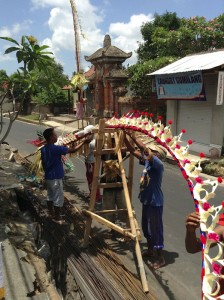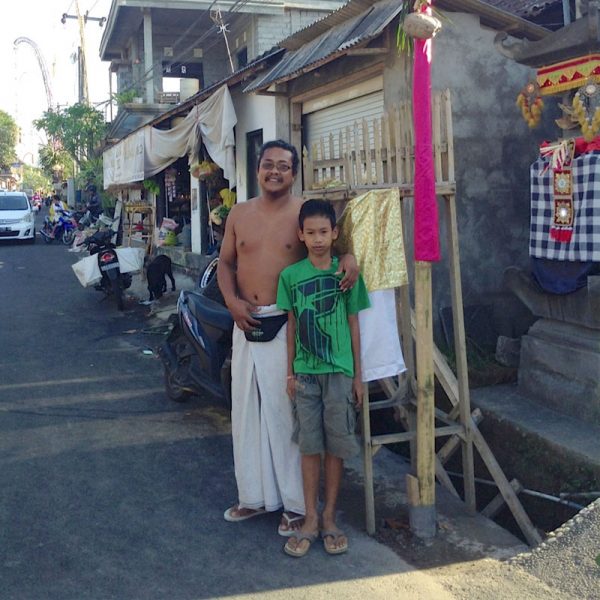It’s a happy time in Bali when Galungan rolls around because the Balinese Hindus believe the Gods come to earth and visit at this time, therefore everything must look beautiful; the temples dressed, the streets cleaned. Bali must look visually appealing and inviting.
About two days before the actual Galungan public holiday, the streets come alive with colour and festive decorations and huge ten-metre bamboo poles hang over the roads making a pictorial archway and a beautiful welcome homecoming for the Gods.
I met Kadek on the street putting the finishing touches to his penjor. He started making penjors when he was nine years old. All Balinese Hindu houses must have a penjor on display twice a year when Galungan is celebrated. In Kadek’s family, seven members of his family worked together to make their creation. In Balinese elementary schools they hold competitions and this serves as good grounding for the practice of making a penjor. The children experiment with design features and this allows a unique artistic expression to evolve. Bali and the arts are constantly in sync with one another.
Penjors are not only for religious functionality like Galungan, but they are also used as adornments for weddings, hotel displays, art performances and special occasions when a guest of honour is in attendance at a function.
Kadek has made over fifty penjors in his lifetime. He explained to me, “Boys make the penjor and the girls help at the very end of the process by adding the hanging piece. You know,” he joked, “Girls always have the last say.”
Kadek went on to explain to me that five years ago it was necessary to go into the forest yourself and take the bamboo. “We must search for the pole with a good bend at the end,” he said. Also in the past you had to gather the coconut leaves and young palm leaves yourself and hand-make all the decorations. This process would take some time.


It’s a family affair making a penjor and everyone gives input and contributes their ideas. The penjors stay up for 35 days and then a blessing ceremony is performed and all the decorations are burnt.
“It is fine for the bamboo to be kept and reused for the next time,” Kadek told me, “As long as you have somewhere to store it and keep it in good order.”
Kadek’s penjor cost Rp.700,000 and the money was pooled together. The family went off to the Pelitan market and bought all the decorative pieces. What is interesting when you stop and look at a penjor are the small little cages that sit elevated on the bamboo pole. The triangular shaped cages called sanggah cucuk are made from bamboo and offerings are placed inside. At Galungan, a penjor must have bamboo, a leaf, a coconut, sanggah cucuk and a cake. Its purpose is to act as a temporary throne and a welcoming to the Gods. Around this little cage you will see yellow and white tethers of material which symbolizes a holy offering.
Galungan is a Balinese holiday celebrating the victory of dharma over adharma. It marks the time when the ancestral spirits visit the Earth. The last day of the celebration is Kuningan, when they return. The date is calculated according to the 210-day Balinese calendar.




